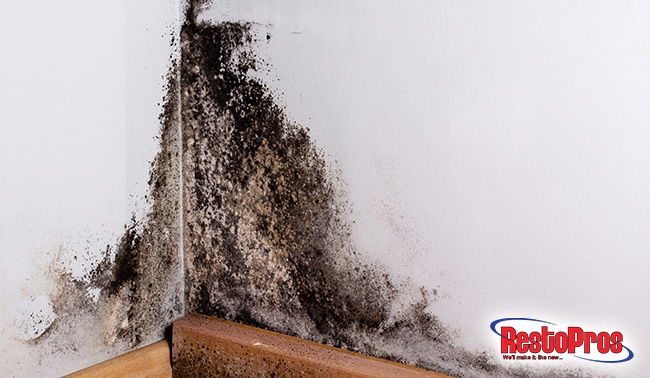Black mold is a common industry term used by experts in the field and, more recently, by concerned homeowners. The name sounds threatening, like something you would hear in a horror movie. ‘Everyone get out of the theater! The black mold is coming!’ It has been the subject of erroneous internet rumors, backed by misinformation about its toxicity and its effects on a household.
While all residential mold should be taken seriously, it’s important to deal with any infestation with factual information. A good starting point is to remember to treat all mold the same. Do not attempt to clean or investigate mold without the proper safeguards – including gloves and a face mask. Always abide by safety precautions and contact a professional mold remediation company (such as RestoPros) immediately if an infestation has gotten out of control.
What Is Black Mold?
- Stachbotrys chartarum, also known as Stachbotrys atra, is often referred to as black mold.
- Stachbotrys chartarum is a mold that produces mycotoxins, which are toxic substances released by a fungus.
- Houses and buildings with water damage and dark areas are the preferred locations for Stachbotrys chartarum to grow and reproduce.
- Contaminated plant material entering your house can cause this mold to grow as well.
- Although this mold is not as common as other household molds, it is not rare either.
- Other molds can be black in color, but Stachbotrys chartarum is most associated with the name.
How Dangerous Is Black Mold?
- Tons of speculation surround the dangers of black mold, describing it as toxic and sometimes deadly.
- No scientific evidence has concluded Stachbotrys chartarum is a severe health risk to most people, but allergy and sickness symptoms may arise from the mycotoxins it produces.
- Although there is little scientific evidence that links black mold to inflammatory responses, mycotoxins have been documented to cause headaches, nasal congestion, and chronic coughing.
- Infants, elderly, and those with weak immune systems can have more severe symptoms from mycotoxin exposure, and should be removed from areas infected with black mold.
Can Black Mold be Identified?
- With over 100,000 different types of mold, it’s often difficult to determine which kind is in your home.
- Black is a very common color for all mold, making it a challenge to identify Stachbotrys chartarum.
- Check any areas of your home that are dark and have moisture, and focus on finding all mold.
- A single room in your house can have several types of mold living there, making it less important to identify than to remove outright.
- All types of invasive mold should be treated and removed by mold remediation professionals.
Black mold is not the toxic horror show that many have been led to believe. However, any mold outbreak in your home should be treated with both caution and immediacy. If you have mold growing in your home, contact RestoPros immediately. We can respond quickly to mold outbreaks and mold damage and have been helping our neighbors in the Dallas/Fort Worth area for years. Give us a call at 855-587-3786 to schedule an appointment with the most trusted mold remediation company in the metroplex.

